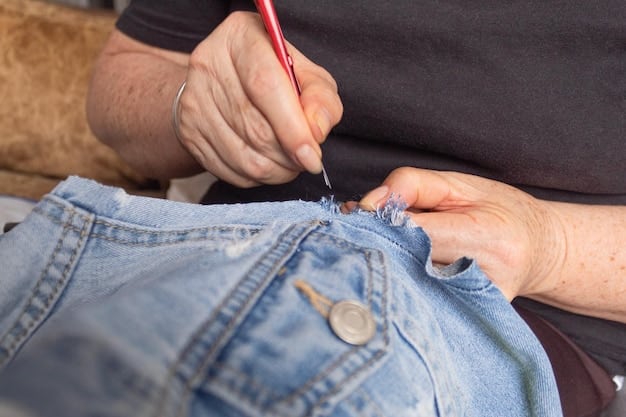Sustainable Fashion: Planet-Friendly Wardrobe Guide

Building a sustainable fashion wardrobe involves intentional choices prioritizing ethical production, environmental impact, and longevity, allowing consumers to align their values with their spending habits and reduce their ecological footprint while managing their finances effectively.
In a world increasingly aware of its ecological footprint, the allure of fast fashion is waning. Consumers are searching for ways to align their values with their purchasing power, particularly when it comes to what they wear. This pursuit leads us to the realm of sustainable fashion: how to build a wardrobe that’s good for the planet and your wallet. It’s a journey from impulsive buys to conscious consumption, impacting not just your style but also the global supply chain, worker rights, and environmental health.
Understanding the True Cost of Fast Fashion
Fast fashion has revolutionized the industry, offering trendy clothes at incredibly low prices, often mirroring high-fashion designs within weeks. This rapid production cycle, however, comes at a significant cost, one often hidden from the consumer. It’s an economic model built on speed and disposability, leading to a constant demand for newness.
The environmental damage is extensive. From the cultivation of resource-intensive crops like conventional cotton, requiring vast amounts of water and pesticides, to the dyeing processes that pollute waterways with toxic chemicals, each step of the fast fashion cycle leaves a heavy footprint. Microplastic shedding from synthetic fabrics, like polyester and nylon, is also a growing concern, as these tiny fibers enter our oceans and food chains.
Environmental Footprint of the Industry
The textile industry is one of the largest polluters globally. Its impacts are multifaceted, affecting various ecosystems and human health. Understanding these impacts is the first step towards embracing a more sustainable approach.
- Water Consumption: Producing a single cotton t-shirt can require thousands of liters of water.
- Chemical Pollution: Dyeing and finishing processes release hazardous chemicals into water sources, impacting biodiversity.
- Waste Generation: The sheer volume of disposable clothing leads to mountains of textile waste in landfills, much of which is non-biodegradable.
- Greenhouse Gas Emissions: Manufacturing, transportation, and disposal all contribute significantly to global carbon emissions.
Social and Ethical Concerns
Beyond environmental degradation, fast fashion often operates on a foundation of precarious labor practices. Garment workers, predominantly women in developing countries, frequently face low wages, long hours, unsafe working conditions, and a lack of basic human rights. The competitive pressure to produce quickly and cheaply incentivizes factories to cut corners, often at the expense of worker welfare. Tragedies like the Rana Plaza collapse in Bangladesh in 2013 served as a stark reminder of the human cost embedded within the industry’s supply chains.
Addressing these issues requires systemic change, but consumer choices play a vital role. By supporting brands committed to ethical sourcing and fair labor, individuals can contribute to a more just and equitable fashion industry. This shift away from unchecked consumerism towards mindful purchasing is fundamental to fostering a sustainable future for clothing production and consumption.
Key Principles of Sustainable Fashion
Embracing sustainable fashion means understanding and adopting a set of core principles that guide purchasing decisions and wardrobe management. These principles move far beyond simply choosing “eco-friendly” materials; they encompass the entire lifecycle of a garment, from its inception to its eventual disposal or repurposing. It’s about designing a more conscientious approach to personal style, ensuring that every piece in your closet tells a story of responsibility.
Longevity and Quality Over Quantity
One of the most impactful shifts you can make is prioritizing quality over ephemeral trends. Instead of buying numerous cheap items that quickly wear out, invest in fewer, well-made pieces designed to last. High-quality garments often have better construction, more durable fabrics, and timeless designs, reducing the need for constant replacement. This approach not only saves you money in the long run but also significantly decreases your contribution to textile waste.
Building a wardrobe based on longevity means looking beyond the immediate desire for novelty. It necessitates a thoughtful consideration of how an item will integrate with your existing clothes and whether its style will endure. Think about versatility and timelessness, opting for pieces that can be dressed up or down and adapted to various seasons or occasions.
Ethical Production and Fair Labor
Ethical production ensures that garments are made under fair and humane conditions. This means workers receive living wages, work reasonable hours, and are in safe environments free from exploitation. Transparency in the supply chain is crucial here; consumers should look for brands that are open about their manufacturing processes and provide verifiable information about their factory partners. Certifications from organizations like Fair Trade or SA8000 can offer some assurance, signaling a brand’s commitment to social responsibility.
Supporting ethical brands sends a clear message to the industry: that consumer demand for responsible practices is growing. It’s a powerful way to advocate for human rights and contribute to a global economy that values people over profit. Researching brands before purchase becomes an integral part of sustainable shopping.
Eco-Friendly Materials and Processes
The choice of materials profoundly impacts the environmental footprint of clothing. Sustainable materials include organic cotton, hemp, linen, and recycled fibers (like recycled polyester or nylon). These options often require less water, fewer pesticides, and produce less waste during their production. Innovative materials like Tencel™ Lyocell and Piñatex also offer promising alternatives, derived from sustainably managed resources.
- Organic Cotton: Grown without synthetic pesticides or fertilizers, reducing soil and water pollution.
- Hemp and Linen: Naturally resilient and require minimal water and no pesticides to grow.
- Recycled Materials: Give new life to existing waste, diverting it from landfills.
- Closed-Loop Systems: Brands in this system recycle water and chemicals, minimizing discharge.
Beyond materials, environmentally conscious production processes, such as water-saving dyeing techniques and reduced energy consumption in manufacturing, are equally vital. Look for brands that actively invest in green technologies and strive to minimize their carbon footprint throughout their operations. This holistic approach ensures that environmental considerations are integrated at every stage of the garment’s creation.
Starting Your Sustainable Wardrobe Journey
Embarking on the path to a sustainable wardrobe can feel daunting, but it doesn’t require an overnight overhaul. It’s a gradual process of intentional decision-making and cultivating new habits. The key is to start small, understanding that every conscious choice contributes to a larger positive impact. This journey is as much about slowing down consumption as it is about making better purchasing choices.
Assess Your Current Wardrobe
Before you buy anything new, take stock of what you already own. This step is crucial for identifying gaps, understanding your personal style, and avoiding redundant purchases. Consider what pieces you truly love, what you wear often, and what no longer serves a purpose.
A thorough wardrobe assessment involves several key actions:
- Declutter: Remove items that don’t fit, are damaged beyond repair, or no longer align with your style.
- Identify Gaps: Determine what essential pieces you lack that would make your existing wardrobe more versatile.
- Understand Your Style: Recognize patterns in what you wear and love, informing future sustainable choices.
This process of “shopping your closet” can inspire new outfit combinations and highlight the versatility of your current garments, often revealing that you have more than you think you do. It’s an exercise in mindful appreciation and reduces the urge to constantly acquire new items.
Define Your Personal Style and Needs
Once you know what you have, clarify what you need. Developing a strong sense of personal style is fundamental to sustainable fashion. When you understand what genuinely makes you feel good and confident, you’re less likely to be swayed by fleeting trends and more likely to invest in pieces that truly reflect who you are. This clarity reduces impulse buys and ensures every new addition is a valuable one.

Consider your lifestyle: what activities do you engage in most often? Do you need clothes for work, casual outings, active pursuits, or special occasions? Tailoring your wardrobe to your actual needs, rather than imagined ones, prevents waste. The goal is to build a cohesive collection of versatile pieces that work together seamlessly, maximizing the number of outfits you can create from a limited number of items.
Research Sustainable Brands and Certifications
The market for sustainable fashion is growing, but it requires diligent research to navigate. Look beyond marketing claims and delve into a brand’s actual practices. Seek out certifications that verify ethical and environmental standards. Familiarize yourself with common sustainable materials and what makes them preferable.
Websites like Good On You, Eco-Stylist, and The Conscious Edit provide ratings and directories of sustainable brands, making it easier to find companies that align with your values. Don’t be afraid to ask brands directly about their supply chains, labor practices, and environmental initiatives. A truly sustainable brand will be transparent and proud to share this information.
Smart Shopping for a Sustainable Wardrobe
Building a sustainable wardrobe isn’t just about what you buy; it’s also about where and how you buy it. Moving away from conventional retail requires a shift in mindset and an exploration of alternative shopping channels. This mindful approach helps you acquire quality pieces while minimizing your environmental and social impact.
Embrace Secondhand and Vintage
The most sustainable garment is often one that already exists. Shopping secondhand or vintage is an excellent way to extend the life cycle of clothing, preventing items from ending up in landfills. This approach is not only environmentally friendly but also incredibly budget-friendly, allowing you to discover unique pieces with character.
Secondhand shopping has numerous benefits:
- Reduces Waste: Keeps clothes out of landfills and gives them a second life.
- Saves Resources: No new resources (water, energy, dyes) are needed for production.
- Unique Finds: Discover one-of-a-kind pieces that won’t be found in mainstream stores.
- Cost-Effective: Generally much cheaper than buying new, stretching your budget further.
Explore local thrift stores, consignment shops, charity shops, and online platforms like ThredUp, Poshmark, and The RealReal. Vintage stores offer a curated selection of older, often higher-quality garments. It requires patience and a keen eye, but the reward is a truly individual and sustainable wardrobe.
When buying secondhand online, always check sizing charts and descriptions carefully, as returns can be less straightforward. For in-person thrifting, focus on quality materials and good construction, as minor flaws can often be easily repaired.
Invest in Versatile Core Pieces
Once you’ve assessed your current wardrobe and identified gaps, focus on acquiring versatile core pieces from sustainable brands. These are the foundational items that can be mixed and matched to create numerous outfits for various occasions. Think classic cuts, neutral colors, and durable fabrics that withstand trends and time.
Examples of versatile core pieces include a well-fitting pair of jeans, a classic white shirt, a comfortable knit sweater, a tailored blazer, and a simple black dress. By building a strong base of these essentials, you reduce the need for excessive purchases of trendy items. Each new addition to your wardrobe should ideally complement multiple existing pieces, maximizing its utility. This strategic approach ensures every item earns its place in your closet.
Consider Rental, Swapping, and Repair
Beyond buying, explore alternative models of clothing consumption. Renting formal wear or occasional pieces can save money and reduce the need for ownership for infrequently used items. Clothing swaps with friends or community groups allow you to refresh your wardrobe without spending money or consuming new resources. This circular approach fosters community and creatively extends the life of garments.
Crucially, learn to repair. Minor tears, missing buttons, or loose seams do not necessitate discarding a garment. Simple mending skills can significantly prolong the life of your clothes. Many communities also offer repair cafes or professional tailors who can handle more complex alterations and repairs. Embracing repair means valuing what you own and resisting the throwaway culture, making “mend and make do” a core part of your sustainable fashion philosophy.
Caring for Your Sustainable Wardrobe
The journey to a truly sustainable wardrobe doesn’t end with conscious purchasing; it extends to how you care for your clothes. Proper garment care can significantly prolong their lifespan, reduce your environmental footprint, and save you money. It’s a proactive step in minimizing waste and maximizing the value of your investments.
Mindful Washing and Drying
How you wash and dry your clothes has a substantial impact on both their longevity and the environment. Over-washing, using hot water, and harsh detergents can damage fibers, cause colors to fade, and contribute to microplastic shedding from synthetics. Conversely, mindful washing practices conserve water and energy while keeping your clothes looking better for longer.
Key mindful washing practices include:
- Wash Less Often: Only wash garments when truly necessary. Airing out clothes or spot cleaning can often suffice.
- Use Cold Water: Cold water washing effectively cleans most clothes and dramatically reduces energy consumption.
- Gentle Cycles: Use gentler wash cycles to protect delicate fabrics and reduce fiber shedding.
- Eco-Friendly Detergents: Choose detergents free from harsh chemicals and phosphates, which can pollute waterways.
When it comes to drying, air drying is the most energy-efficient and gentle option. Tumble dryers consume a lot of energy and can cause clothes to shrink or wear out faster. If you must use a dryer, opt for lower heat settings and remove clothes while they are still slightly damp to minimize energy use.
Proper Storage and Maintenance
Storing your clothes correctly prevents damage and keeps them in wearable condition. Understand the specific needs of different fabrics. For instance, knitwear should be folded to prevent stretching, while delicate items might benefit from padded hangers. Ensure your closet is not overcrowded, as this can lead to wrinkles and damage.

Regular maintenance, such as promptly mending small tears or reattaching buttons, prevents minor issues from becoming irreparable problems. Protect delicate items from snags and pulls. Consistent attention to these details can make a significant difference in how long your clothes remain a functional and enjoyable part of your wardrobe.
Repurpose and Recycle Old Clothes
Even with the best care, clothes eventually reach the end of their wearable life. When a garment is truly beyond repair or reuse, consider repurposing or recycling options rather than simply discarding it. Creative repurposing can transform old clothes into cleaning rags, DIY projects, or new accessories. For instance, old t-shirts can become tote bags or dishcloths.
Many textile recycling programs accept worn-out garments for conversion into insulation material, industrial wiping cloths, or new textile fibers. Research local initiatives or check if your favorite brands offer take-back programs for their used clothing. By closing the loop and keeping textiles out of landfills, you complete the sustainable fashion cycle, ensuring that even end-of-life garments have a purpose.
Building a Wardrobe for Your Wallet and the Planet
The financial benefits of a sustainable wardrobe are often overlooked, yet they are substantial. While the initial investment in higher-quality, ethically produced pieces may seem higher, the long-term savings are significant. This approach moves away from the costly cycle of constant replacement fueled by fast fashion’s disposability, ultimately leading to a more financially sound and environmentally responsible clothing consumption model.
Long-Term Cost Savings
The upfront cost of a responsibly made garment might be more than its fast fashion counterpart, but its durability means you’ll buy less often. Consider the “cost per wear” rather than just the purchase price. A well-made coat that lasts ten years, even if it costs five times more than a fast fashion alternative, will prove far more economical in the long run. You avoid repeated purchases of inferior items, saving money, time, and mental energy.
Moreover, reduced washing and drying needs, and the emphasis on repair, further contribute to savings on utility bills and replacement costs. The combined effect is a wardrobe that is not only good for the planet but also a smart investment for your personal finances.
Reduced Environmental Footprint
Every decision, from sourcing to disposal, in a sustainable wardrobe minimizes environmental damage. By choosing organic materials, supporting ethical production, and extending the life of your clothes, you directly contribute to:
- Lower Resource Consumption: Less water, energy, and raw materials used.
- Reduced Pollution: Fewer chemicals released into ecosystems.
- Decreased Waste: Less textile waste ending up in landfills.
- Fairer Labor Practices: Supporting a more humane global supply chain.
This holistic approach means your clothing choices become a powerful personal statement, reflecting a broader commitment to environmental stewardship and social justice. It’s about being part of the solution, not the problem.
Challenges and the Path Forward
The transition to sustainable fashion is not without its challenges. Accessibility, affordability, and entrenched consumer habits all present hurdles. However, awareness is growing, and innovations are continually emerging, paving a more accessible path forward for both consumers and the industry as a whole.
Addressing Affordability and Accessibility
Sustainable fashion often carries a higher price tag due to ethical labor practices, quality materials, and smaller production runs. This can be a barrier for many consumers. However, alternative avenues like secondhand shopping, clothing swaps, and repairing existing garments provide cost-effective solutions. Furthermore, as demand for sustainable fashion grows, economies of scale may help drive prices down, making ethical choices more widely available.
Government policies and industry regulations also play a crucial role in enhancing accessibility. Incentives for sustainable production and penalties for harmful practices can level the playing field, making sustainable options the norm rather than the exception. Consumer pressure on brands to adopt greener practices can also accelerate this shift.
The Future of Fashion: Innovation and Circularity
The future of sustainable fashion lies in continued innovation and the widespread adoption of circular economy principles. This means designing clothes for longevity, ease of repair, and ultimate recyclability. Brands are experimenting with new materials like lab-grown fabrics, fibers from agricultural waste, and dyeing techniques that use minimal water.
The concept of “clothing as a service” — where garments are leased rather than owned — is gaining traction, further reducing waste and encouraging efficient resource use. Imagine a fashion industry where every piece of clothing is designed to be disassembled and its components reused, creating a truly closed-loop system. While this vision is still evolving, the increasing investment in research and development points towards a more regenerative and less extractive fashion future.
Consumer demand for transparency, ethical production, and environmental responsibility is a powerful driver for change. By continuing to make conscious choices, supporting innovative brands, and advocating for systemic shifts, individuals play a critical role in shaping a fashion industry that serves both people and the planet.
| Key Point | Brief Description |
|---|---|
| ♻️ Secondhand First | Prioritize buying used clothing to extend garment life and reduce waste. |
| 🌿 Eco-Materials | Choose items made from organic or recycled fibers for lower environmental impact. |
| 🛠️ Mend & Repair | Extend garment lifespan by repairing minor damage instead of discarding. |
| 💧 Mindful Care | Wash less, use cold water, and air dry to save energy and preserve clothing. |
Frequently Asked Questions about Sustainable Fashion
▼
Sustainable fashion is an approach to designing, manufacturing, and buying clothes that maximizes benefits to the environment and communities while minimizing social and environmental harms. It challenges the fast fashion model by promoting ethical production, eco-friendly materials, and longevity of garments to reduce waste and pollution.
▼
Fast fashion significantly harms the environment through excessive water consumption for crops like cotton, chemical pollution from dyeing processes, and massive textile waste in landfills. It also contributes to carbon emissions from manufacturing and transportation, and microplastic pollution from synthetic fibers shed during washing.
▼
Initially, sustainable fashion items can have a higher upfront cost due to fair labor practices and quality materials. However, they generally last longer, reducing the need for frequent replacements. This often results in long-term cost savings, making it a more economical choice over time due to a lower “cost per wear.”
▼
You can find sustainable clothes by prioritizing secondhand options from thrift stores, consignment shops, and online platforms like ThredUp or Poshmark. Additionally, research brands with strong ethical and environmental certifications, often found through dedicated sustainable fashion directories or by checking brand transparency reports.
▼
Eco-friendly materials are those produced with minimal environmental impact. Examples include organic cotton, hemp, and linen, which require less water and fewer pesticides. Recycled materials like recycled polyester or nylon also qualify, as they repurpose existing waste, reducing resource consumption and landfill burden.
Conclusion
Building a sustainable wardrobe is a transformative journey that extends far beyond mere clothing choices—it’s a commitment to mindful consumption, ethical living, and environmental stewardship. By understanding the true costs of fast fashion, embracing longevity, supporting ethical production, and caring for what we own, we can create a wardrobe that not only reflects our personal style but also aligns with our deepest values. This shift isn’t just a trend; it’s a vital step towards a more equitable and ecologically sound future for the planet and our own well-being.





